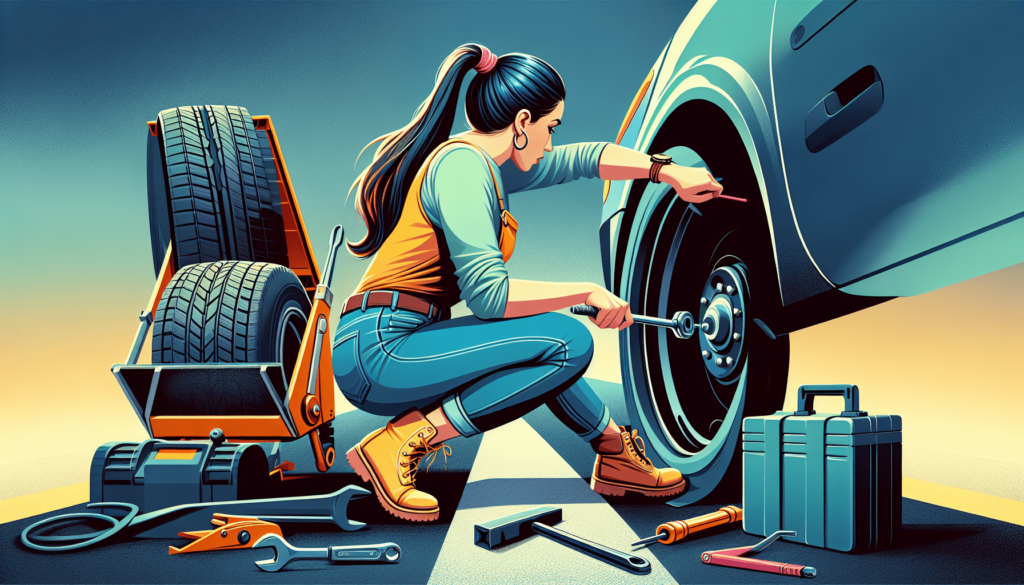Imagine you’re driving down a scenic highway, the wind in your hair and the open road ahead. Suddenly, an unexpected hiccup occurs – your car starts making strange noises and loses power. Panic sets in as you wonder how on earth you’ll handle this unforeseen vehicle repair situation while stranded on the side of the road. Fear not, as this article will guide you through the necessary steps to handle vehicle repairs when you’re out and about. From finding a reliable mechanic to understanding your insurance coverage, we’ve got you covered every step of the way. So, sit back, relax, and let’s explore how you can successfully handle those bothersome vehicle repairs while on the road.

Prepare for Roadside Emergencies
Keep a roadside emergency kit
It is always wise to be prepared for unexpected roadside emergencies. One of the best ways to ensure your safety and well-being is to have a roadside emergency kit in your vehicle at all times. This kit should include essential items such as a first aid kit, a flashlight with extra batteries, reflective warning triangles, a tire pressure gauge, and a basic toolkit consisting of pliers, screwdrivers, and an adjustable wrench. Additionally, consider including a spare cell phone charger, extra blankets, and non-perishable snacks in case you find yourself stranded for an extended period.
Know how to change a tire
Knowing how to change a tire is a vital skill that every driver should have. Flat tires can happen at any time and having the knowledge and confidence to handle this situation will save you from being stranded on the side of the road for an extended period. Familiarize yourself with the process by reviewing your vehicle’s owner’s manual or watching online tutorials. Practice changing a tire in a controlled environment so that you feel comfortable doing it when an emergency arises.
Have a spare tire and necessary tools
In addition to knowing how to change a tire, it is crucial to have a spare tire and the necessary tools for the job. Make sure your vehicle is equipped with a functional spare tire that is properly inflated. Check the condition of your spare tire regularly to ensure it has not deteriorated over time. Alongside the spare tire, keep the required tools, including a jack and lug wrench, readily accessible in your vehicle. These tools are vital for removing the damaged tire and replacing it with the spare.
Carry jumper cables
A dead battery can be a common issue that leaves you stranded on the roadside. Carrying a set of jumper cables can be a lifesaver in such situations. These cables allow you to jump-start your vehicle by connecting your battery to another vehicle’s battery. It is essential to know the correct procedures for using jumper cables to avoid any damage to your vehicle or potential injury. Keep the jumper cables in your vehicle at all times, and don’t forget to review the proper steps for jump-starting a car.
Keep emergency contact numbers
One often overlooked aspect of being prepared for roadside emergencies is having easy access to emergency contact numbers. In case of a severe accident or medical emergency, you’ll want to quickly contact the appropriate authorities or medical professionals. Additionally, keeping a list of emergency contacts, including your insurance provider and roadside assistance service, can save time and ensure that help is on the way when you need it the most. Save these numbers in your phone contacts and consider having a written copy in your glove compartment, just in case.
Identify the Issue
Observe warning signs or strange noises
When you encounter vehicle troubles on the road, the first step is to pay attention to any warning signs or strange noises. These can be indicators that something is amiss with your vehicle. Whether it’s a grinding noise, a burning smell, or an unexpected warning light on the dashboard, taking note of these signs can help you better communicate the issue to a repair technician later on. Ignoring or dismissing these signs may lead to more significant problems down the road, so be attentive to any new or unusual symptoms your vehicle exhibits.
Check engine light
The check engine light is one of the most common warning lights that can appear on your vehicle’s dashboard. When this warning light illuminates, it indicates that your vehicle’s onboard computer has detected a potential issue. While a check engine light doesn’t necessarily mean immediate danger, it is crucial to address the problem promptly. Ignoring the check engine light can result in more severe damage to your vehicle and may even lead to a breakdown on the road. When the light comes on, it’s best to have your vehicle inspected by a professional to diagnose and resolve the underlying issue.
Monitor temperature gauge
The temperature gauge on your vehicle measures the temperature of your engine coolant. A sudden increase in engine temperature can be a sign of a cooling system problem or a potential coolant leak. If you notice the temperature gauge creeping into the red zone or see steam or smoke coming from under the hood, it is essential to take immediate action. Pull over to a safe location and turn off the engine to prevent overheating and potential engine damage. Ignoring cooling system problems can lead to costly repairs and leave you stranded on the side of the road.
Listen for abnormal sounds
Unusual sounds coming from your vehicle can be an indication of a problem. Pay attention to any rattling, clunking, grinding, or squealing noises that you may hear while driving. These sounds can stem from issues with various components of your vehicle, such as the engine, transmission, braking system, or suspension. By being mindful of these sounds and noting when they occur (e.g., during acceleration, braking, or turning), you can provide valuable information to a repair technician, helping them diagnose and address the problem effectively.
Find a Safe Location
Pull over to a safe spot
When you encounter a vehicle issue while driving, it is crucial to pull over to a safe location as soon as possible. Look for a wide shoulder, a parking lot, or a designated rest area where you can park your vehicle out of the flow of traffic. Avoid stopping on a curve or hill where your vehicle might be difficult for other drivers to see. If you’re on a highway, exit at the nearest off-ramp and find a safe place away from the high-speed traffic.
Use hazard lights and warning triangles
Once you have safely pulled over, it is important to alert other drivers to your presence. Activate your hazard lights by turning them on. This will make your vehicle more visible to other drivers, especially during low light conditions or inclement weather. Additionally, if you have reflective warning triangles in your emergency kit, place them a safe distance behind your vehicle to provide advanced warning to oncoming traffic.
Park away from traffic
If possible, park your vehicle away from oncoming traffic to reduce the risk of accidents or further damage. If your vehicle has stalled or is not drivable, try to steer it onto the shoulder or as far onto the side of the road as possible. By doing so, you’re creating a safer environment for yourself and others on the road. Be mindful of any inclines, curves, or blind spots that could pose a danger to you and your vehicle.
Assess the Situation
Determine if it’s a minor or major issue
Once you have safely parked your vehicle, take a moment to assess the situation and determine whether the problem you’re facing is a minor or major issue. If it’s a minor issue such as a flat tire or a blown fuse, it may be something you can address on your own with the help of a few tools or a replacement part. However, if you’re experiencing more significant problems such as engine failure or transmission issues, it’s best to seek professional help.
Try to troubleshoot the problem
If it’s safe to do so and you have some knowledge about your vehicle, you can try to troubleshoot the problem yourself. For example, if your engine won’t start, checking the battery connections, ensuring the fuel pump is functional, or examining the spark plugs can help you pinpoint the issue. However, be cautious when attempting DIY repairs, as you don’t want to aggravate the problem or put yourself at risk. If you’re unsure about the troubleshooting steps or lack the necessary tools, it’s best to leave it to the professionals.
Consult the vehicle manual
Your vehicle’s manual can be a valuable resource when it comes to understanding the inner workings and troubleshooting procedures for your specific make and model. Keep your vehicle’s manual in the glove compartment, ensuring it’s easily accessible in an emergency. The manual will provide you with valuable information on topics such as fuse locations, recommended tire pressure, and maintenance schedules. By consulting the manual, you may find guidance on resolving minor issues or gain a better understanding of the problem before seeking professional help.
Contact roadside assistance if needed
If the problem exceeds your abilities or if you’re uncomfortable attempting repairs, it’s time to contact roadside assistance. Roadside assistance services are often included with your insurance policy or may be available through an automobile club. These services specialize in providing the necessary support for stranded motorists, from jump-starting a dead battery to towing your vehicle to a repair facility. Contacting roadside assistance ensures that you have professional help on the way and relieves the stress of handling the situation entirely on your own.

Temporary Repairs
Fixing a flat tire
One of the most common roadside emergencies is a flat tire. While it’s not a permanent fix, knowing how to temporarily fix a flat tire can help you reach a safer location or a nearby tire repair shop. Start by locating a safe space to change the tire and engage your vehicle’s parking brake. With the necessary tools and a spare tire, follow the step-by-step process outlined in your vehicle’s manual or an online tutorial. Remember, a temporary fix is not meant to replace a professional tire repair or replacement, so be sure to have your tire inspected by a professional as soon as possible.
Replacing a blown fuse
If you’re experiencing electrical issues in your vehicle, a blown fuse is often the culprit. To temporarily address this problem, you can replace the blown fuse with a spare fuse of the same rating. The location of the fuse box and the specific fuse to replace can be found in your vehicle’s manual. However, keep in mind that if a fuse blows repeatedly, it may indicate an underlying problem that needs attention from a professional mechanic.
Patching small leaks
Small leaks in your vehicle’s coolant, oil, or other fluids can sometimes be temporarily patched until you can reach a repair facility. Products like leak sealants or emergency leak repair tapes can help provide a quick fix for minor leaks. However, it is crucial to understand that these temporary solutions are not a permanent fix and should only be used as a last resort. It’s best to have the leak properly diagnosed and repaired by a professional to prevent further damage to your vehicle’s systems.
Secure loose parts
During your assessment of the situation, you may notice loose parts or components on your vehicle that require immediate attention. Use your toolkit to secure any loose bolts, fasteners, or body panels that could potentially detach while driving. It’s important to ensure that all parts are securely fastened before continuing your journey. If you’re unsure how to properly secure a loose part or believe the damage is more severe than it appears, it’s best to seek the help of a professional before getting back on the road.
Contact Roadside Assistance or Towing
Call your insurance provider’s roadside assistance
If you have roadside assistance coverage as part of your insurance policy, contact your insurance provider’s roadside assistance hotline. They will be able to guide you through the process of obtaining assistance for your specific situation. Provide them with the necessary details, such as your location, a description of the problem, and any symptoms or warning signs you’ve observed. They will dispatch a professional to your location to assess and address the issue.
Contact a local towing service
If you don’t have roadside assistance coverage through your insurance or prefer to use a local towing service, search for reputable towing companies in your area. Consider reading reviews or asking for recommendations from friends or family. Contact the towing service and explain your situation, providing accurate details about your location and the specific problem you’re facing. The towing service will dispatch a truck to your location to safely transport your vehicle to a repair facility.
Provide accurate location and details
When contacting roadside assistance or a towing service, it’s crucial to provide accurate information regarding your location and the nature of the problem. Providing your precise location, including any notable landmarks or nearby exits, will help the service provider locate you more efficiently. Additionally, describe the issue you’re experiencing with your vehicle as accurately as possible, including any symptoms or warning signs you’ve observed. The more detailed and precise your description, the better equipped the service provider will be to assist you effectively.
Follow instructions from the service provider
Once you’ve contacted roadside assistance or a towing service, it’s essential to follow any instructions they provide. They may ask you to remain in your vehicle with the hazard lights on until help arrives, or they may advise you to move to a safer location if possible. Cooperate fully with the service provider to ensure your safety and the smooth resolution of your vehicle issue. If any circumstances change while waiting for assistance (e.g., a change in your location or the status of the problem), be sure to communicate these updates promptly.
Consider DIY Repairs
Assess your repair skills and knowledge
If you have a basic understanding of automotive repairs and feel confident in your abilities, you may consider attempting DIY repairs. Evaluate your repair skills and knowledge honestly, taking into account the complexity of the problem at hand. Keep in mind that attempting repairs beyond your level of expertise can lead to further damage or safety risks. When in doubt, it’s best to consult a professional mechanic who can provide expert guidance and perform the necessary repairs to ensure your vehicle’s safety and reliability.
Use online resources or forums for guidance
The internet is a wealth of knowledge when it comes to automotive repairs. Online resources, such as tutorials, forums, and how-to videos, can provide step-by-step guidance for a wide range of repairs. These resources can be especially useful for minor repairs or routine maintenance tasks. However, remember that not all sources on the internet are reliable or accurate, so be sure to consult reputable and trusted websites or seek advice from experienced individuals in automotive forums.
Purchase necessary tools and spare parts
Before attempting any DIY repairs, ensure that you have the necessary tools and spare parts to complete the job correctly. Investing in quality tools will not only make the task easier but also ensure your safety. Consult online guides or talk to experts to determine the specific tools required for the repair you’re attempting. Similarly, if you need to replace or repair a specific component, purchase high-quality OEM (Original Equipment Manufacturer) or aftermarket parts that are compatible with your vehicle. Using subpar or incorrect parts can lead to further issues down the line.
Follow safety precautions
When undertaking DIY repairs, it’s crucial to prioritize safety at all times. Working around vehicles can be dangerous, so take necessary precautions to protect yourself and others. Wear appropriate safety gear, such as gloves and safety glasses, to shield yourself from potential hazards. Ensure that you’re working in a well-ventilated area and use caution when dealing with electrical or mechanical components. Additionally, always disconnect the vehicle’s battery before working on any electrical systems. If you encounter unexpected challenges or feel unsure about your progress, don’t hesitate to seek assistance from a professional.
Communicating with Repair Shops
Research nearby repair shops
When it comes to choosing a repair shop for your vehicle, conducting some research beforehand can make a significant difference. Look for reputable repair shops in your area that specialize in the type of repair or maintenance work your vehicle requires. Reading online reviews and checking customer ratings can provide valuable insights into the reliability and quality of the shop’s services. Also, consider asking friends, family, or coworkers for recommendations based on their personal experiences.
Call for availability and estimates
Once you’ve narrowed down your list of potential repair shops, call them to inquire about their availability and estimated costs for the repairs or maintenance services you need. Providing accurate details about your vehicle’s make, model, and specific issue will help the repair shop in providing a more accurate estimate. Ask about the shop’s turnaround time, especially if you need your vehicle repaired quickly, and inquire about any warranties or guarantees offered on the services provided.
Explain the issue clearly
When speaking with the repair shop, it’s essential to explain the issue with your vehicle as clearly and accurately as possible. Utilize the observations you made during the initial assessment of the problem to provide specific details, such as warning signs, abnormal sounds, or any relevant experiences with the issue. The more information you provide, the better the repair technicians will be able to diagnose and address the problem effectively.
Ask about warranty or guarantees
Before committing to a repair shop, inquire about any warranties or guarantees they offer on the services provided. A reputable repair shop will stand behind their workmanship and may offer a warranty on parts and labor. Understanding the terms and duration of any warranty or guarantee on the repairs can provide you with peace of mind and confidence in the quality of the services being performed on your vehicle.
Getting a Rental Vehicle
Check if your insurance covers rentals
When your vehicle requires extensive repairs that will take an extended period, getting a rental vehicle can be a convenient solution to ensure you stay mobile. First, check with your insurance provider to determine if your policy includes coverage for rental vehicles. Understanding the terms and limitations of your coverage will help you navigate the rental process smoothly and avoid any unexpected costs.
Contact rental agencies
Once you’ve confirmed your insurance coverage, contact rental agencies to inquire about availability and rates. Consider reaching out to multiple agencies to compare prices and availability. Provide them with the necessary details, such as the duration you’ll need the rental vehicle and your desired vehicle type or size. If you have any specific requirements or preferences, communicate them to the rental agency to ensure they can accommodate your needs.
Provide required information
When renting a vehicle, you’ll need to provide certain information and documentation. Prepare your driver’s license, insurance information, and a valid credit card to complete the rental process. Some agencies may also require additional identification or documentation, so be sure to inquire about any specific requirements beforehand. By having all the necessary information ready, you can streamline the rental process and get on the road with a temporary vehicle promptly.
Inspect the rental vehicle for damages
Before driving off in the rental vehicle, thoroughly inspect it for any existing damages or issues. Take note of any scratches, dents, or mechanical problems, and notify the rental agency immediately to ensure you’re not held responsible for any pre-existing damage. Document the vehicle’s condition by taking photos or video footage, if possible. This thorough inspection will protect you from potential disputes when returning the rental vehicle.
Preventive Maintenance
Regularly check fluid levels
Regularly checking your vehicle’s fluid levels is essential for maintaining its optimal performance and preventing issues down the line. Monitor the levels of engine oil, coolant, brake fluid, power steering fluid, and windshield washer fluid. Improper fluid levels can lead to decreased performance, overheating, or even engine damage. Consult your vehicle’s manual for the correct procedures and recommended intervals for checking and topping up each fluid.
Inspect tires and brakes
Your vehicle’s tires and brakes are crucial for your safety on the road. Frequently inspect the tread depth, tire pressure, and overall condition of your tires to ensure they meet the manufacturer’s recommendations. Uneven wear, bulges, or cracks can indicate issues that require attention. Additionally, regularly check your brake pads, rotors, and brake fluid levels to ensure optimal braking performance. Addressing any tire or brake issues promptly will contribute to your overall driving safety.
Replace worn-out parts
As your vehicle accumulates mileage, certain parts will naturally wear out over time. Regularly inspect critical components such as belts, hoses, filters, and spark plugs for signs of wear or deterioration. These components play a vital role in your vehicle’s performance, fuel efficiency, and overall reliability. Replace worn-out parts as recommended by the manufacturer or consult with a mechanic to ensure your vehicle continues to operate at its best.
Follow manufacturer’s recommended maintenance
Manufacturers provide detailed maintenance schedules outlining the recommended services and intervals for your specific vehicle. Following these recommendations is crucial for keeping your vehicle in good condition and preventing potential breakdowns. Adhering to the manufacturer’s recommended maintenance can also help preserve your vehicle’s warranty, protecting you from unexpected repair costs. Familiarize yourself with the maintenance schedule outlined in your vehicle’s manual and consult a professional mechanic for any specific concerns or questions.
Navigating vehicle repairs on the road can be a stressful and overwhelming experience. However, by being prepared, identifying the issue, finding a safe location, assessing the situation, and making informed decisions, you can handle roadside emergencies with confidence. Whether it’s a minor repair that you can address yourself or a major issue that requires professional assistance, prioritizing your safety and taking appropriate action will ensure a smoother and safer experience on the road. Remember, training yourself in basic vehicle maintenance, knowing how to change a tire, and having the necessary tools and emergency contacts readily available are invaluable assets that will empower you to handle roadside emergencies effectively.

